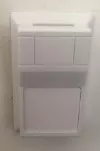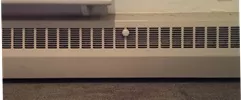How My Heat Works: Radnor
The heating system for Radnor is controlled by a boiler, which is natural gas fired. This boiler heats water that gets pumped through a Main Heating Valve (MHV) and then the radiators in each room.
There are temperature sensors (see photo) in Rooms 108, 215, 216, 307, 316, and 401. The energy management system averages the six sensor temperatures and “calls for heat” when the average is below set point (usually between 68°F and 72°F). On that call for heat, the MHV in Radnor basement opens, sending hot water to the radiators in each room.These rooms with temperature sensors can have a negative effect on the other rooms. For example, if the student in Room 108 (which has a sensor) opens the window, that sensor will cause the average temperature to drop and the heating system to respond by running the pump to warm the space. This sometimes causes an over-heating condition in the building. Conversely, if the student in Room 108 uses a space heater, that sensor will cause the average temperature to rise and the heating system to respond by shutting off the pump and likely making the rooms too cold.
Each radiator has a knob that controls air flow (see photo). This knob will not adjust the temperature of the air being distributed, but will increase or decrease the air flow. It is important to keep the space around your radiators clean and clear of personal items. Blocking air flow to the radiators can cause poor heat circulation.Note: The main heating valve closes any time the outside air temperature is above 60°F. This means that the heat is essentially “off” when the outside temperature reaches 60°F.
Between the hours of 11 a.m. and 3 p.m., Monday through Friday, during the heating season, the target temperature range in all the dorms will be set back to 65-67°F.

